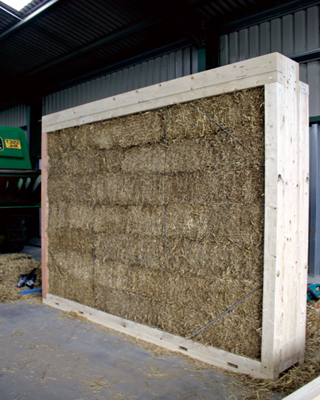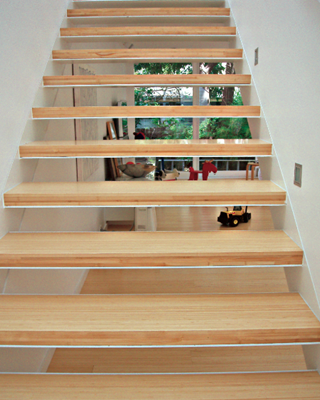In an architectural landscape dominated by bricks and concrete, it can be difficult to open one’s mind to other ways of constructing buildings. However, Warren McLaren discovers a few pioneers are using grass as a serious building medium.
Strawbale
Earlier this year, Sydneysiders discovered a rather unusual new eatery had appeared at The Rocks overlooking the harbour. The completely recyclable Greenhouse café sprung from the fertile imagination of Melbourne-based artist- designer Joost Bakker. A steel frame provided slots into which were dropped bales of straw, creating a thermally efficient wall with insulation approaching R7. Strawbales were also employed in the roof cavity of the loft-like second storey. It would be understandable if some were to dismiss the Greenhouse as some wacky, temporary one-off art installation. Yet in Perth they have a fully fledged version of the same thing, licensed to seat 120 café goers between its walls and ceiling packed with 420 straw bales. More conventional rendered straw bale walls (if one can say that) have almost five times the R-value of a brick veneer wall, according to the Australian Strawbale Building Association.
Hemp Fibre
Even though Australia, unlike the United States, does allow the cultivation of industrial hemp, very few fully commercial crops have been realised, with most of the finished hemp product available for sale being imported. But that range available to interior designers is growing. From 100 per cent hemp floor rugs through to hemp and organic cotton manchester and on to densely woven hemp canvas suitable for upholstery and curtaining. Architects and building designers may, however, be more interested in the decade-long development work of hemp researcher, Klara Marosszeky. Putting heads together with the University of New South Wales’ Centre for Construction Innovation, she has developed a hemp/lime building material that uses the whole hemp stalk fibre, not just the inner hurd. Sourcing a rare Australian-grown crop of industrial hemp Klara is collaborating with a couple to build Australia’s first hemp house at Billen Cliffs Village, near Lismore in Northern NSW.
Green Roof
When it comes using grass in buildings, it’s hard to trump a green roof, with its very obvious crop of verdant green living lawn. Aside from the aesthetic element there are many practical benefits derived from a well engineered green roof. Prime amongst these is the reduction in stormwater runoff, and the reduction in heating and cooling energy loads due to a buffering from climatic conditions.
The US Green Building Council’s (USGBC) Leadership in Energy and Environmental Design (LEED) Green Building Rating System awards points to buildings with green roofs, because they significantly reduce the heat island effect, (where urban development is warmer than nearby rural regions.) New York City has calculated that living roofs are second only to trees in providing a cooling impact on metropolitan areas. For all the latest information on the positive attributes of living roof design, contact Green Roofs Australasia who are organising their 2011 conference in Sydney in mid November.
Straw Panel

A few months ago Britain’s University of Nottingham opened their new Biosciences building which had been constructed with prefabricated Modcell panels.
These 14-metre-long panels are actually a cross-laminated timber frame filled with compressed straw. Modcell has a process they call Flying Factories, whereby they rent buildings within a 10 mile (16 km) radius of a project to fabricate the panels.
Adding to the localised aspects of this particular project both the straw and the timber were sourced mostly from the University’s own farmland properties. Modcell offers a level of thermal insulation up to three times higher than current UK building regulations, so it’s not surprising it also meets PassivHaus specifications.
John and Susan Glassford, of Huff’n’Puff, among the pioneers of strawbale in Australia, have long advocated such a construction method here. John is pursuing his own development in this area. He calls them SITUPS, for super insulated tilt-up panel system.
Thatch roofing – an Australian staple
 Architectural historian, Miles Lewis, in his exhaustive investigation, Australian Building: A Cultural Investigation (available free online) points out that thatch roofing has long been a staple of Australian architecture.
Architectural historian, Miles Lewis, in his exhaustive investigation, Australian Building: A Cultural Investigation (available free online) points out that thatch roofing has long been a staple of Australian architecture.
From “porcupine” and tussock grasses used by indigenous Australia, through the many varied forms experimented with by the early settlers. Although thatch might be undergoing something of a renaissance in Europe and the United Kingdom for its historical and renewable qualities, the same is not true in Australia. Except maybe in the application of gazebos, pool huts and BBQ shelters.
Here, the likes of imported Indonesian thatch in the form of alang-alang grass is often deployed. Alternatively Cape Reed thatch is sourced from South Africa, and has been used successfully in windy coastal regions of Western Australian. Although thatch’s dense mat is quite rainproof, the matrix of the longitudinal fibres allows air to pass through, reducing resistance and enhancing resilience to damaging winds.
Hempcrete
Hemp may not be a grass in the true taxonomy tradition, so please indulge a little poetic license. The external sheath of hemp is tough fibre used for textile products. Hiding beneath that tough outer surface is the softer pithy ‘hurd’ or ‘shiv.’ Mixed with a lime-based binder and water this hemp stalk by-product sets like masonry. Even though it has concrete like qualities, Hempcrete is said to sequester up to 100kg of carbon dioxide per cubic metre used, whilst offering significant insulation characteristics (R 4.2 for a 300mm thick wall). Forty-two green homes have been built with the stuff in England, in a joint venture between Grand Design’s Kevin McCloud, his company Hab and housing group GreenSquare. Due to be completed in 2012 Marks & Spencer’s second largest retail store in the UK has external walls made with 226 pre-fabricated panels of hempcrete infill. Australia now has a distributor of Hempcrete so expect to hear more about its uses locally.
Bamboo
 One of the fastest growing plants on the planet, bamboo can attain heights of 15 metres in just three months, making it harvestable in one tenth of the time of many hardwood trees. Yet, remarkably, bamboo used for flooring, can record a hardness much greater than the likes of Jarrah and Blackbutt timber.
One of the fastest growing plants on the planet, bamboo can attain heights of 15 metres in just three months, making it harvestable in one tenth of the time of many hardwood trees. Yet, remarkably, bamboo used for flooring, can record a hardness much greater than the likes of Jarrah and Blackbutt timber.
Bamboo’s most stellar trajectory in the past few years, however, has been in the form of textile-based homewares. Unfortunately this has been under false pretences, as bamboo was merely a feedstock for the highly polluting rayon (aka viscose) cellulose extrusion process.
Whilst bamboo flooring is more benign, it is worth ensuring adhesives and binders meet European standards for low toxicity. And be aware ‘natural’ bamboo comes coated in half a dozen or more layers of polyurethane. For something a little different check out Eco- Core’s offerings of bamboo for kitchen worktops and other forms of cabinetry.

